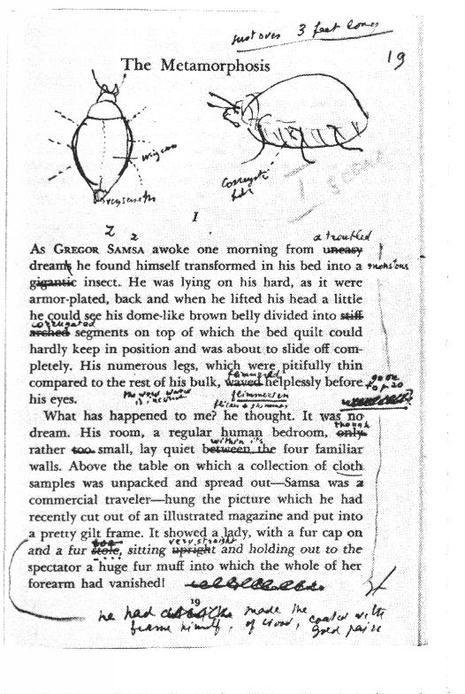
This is the opening page of “The Metamorphosis,” from Vladimir Nabokov’s teaching copy. Kafka’s novella held a special interest for Nabokov, who was a trained entomologist. From his lecture notes at Cornell:
Now, what exactly is the ‘vermin’ into which poor Gregor, the seedy commercial traveler, is so suddenly transformed? It obviously belongs to the branch of ‘jointed leggers’ (Arthropoda), to which insects, and spiders, and centipedes, and crustaceans belong. … Next question: What insect? Commentators say cockroach, which of course does not make sense. A cockroach is an insect that is flat in shape with large legs, and Gregor is anything but flat: he is convex on both sides, belly and back, and his legs are small. He approaches a cockroach in only one respect: his coloration is brown. That is all. Apart from this he has a tremendous convex belly divided into segments and a hard rounded back suggestive of wing cases. In beetles these cases conceal flimsy little wings that can be expanded and then may carry the beetle for miles and miles in a blundering flight. … Further, he has strong mandibles. He uses these organs to turn the key in a lock while standing erect on his hind legs, on his third pair of legs (a strong little pair), and this gives us the length of his body, which is about three feet long. … In the original German text the old charwoman calls him Mistkafer, a ‘dung beetle.’ It is obvious that the good woman is adding the epithet only to be friendly. He is not, technically, a dung beetle. He is merely a big beetle.
“Curiously enough,” he added, “Gregor the beetle never found out that he had wings under the hard covering of his back. This is a very nice observation on my part to be treasured all your lives. Some Gregors, some Joes and Janes, do not know that they have wings.”
